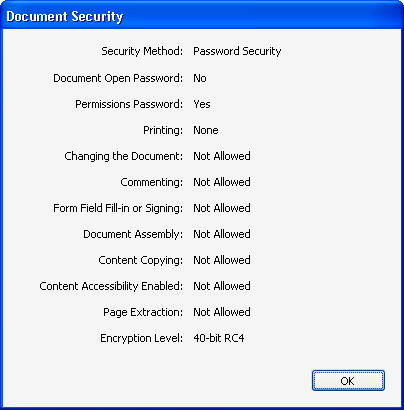Adobe Acrobat features two levels of password protection.
Protecting document with access restriction ("owner", so-called "security" or "master") password does not affect a user's ability to open and view the PDF file, but prevents user from editing (changing) the file, printing it, selecting text and graphics (and copying them into the Clipboard), adding/changing annotations and form fields etc (in any combination). If the file is protected this way, you open it in Adobe Acrobat Reader (again, the password is not required for that) and select File | Properties menu item, Security, Show Details, the following information is shown (for example):

Fortunately, there is no need to recover that password at all: instead, we can remove it (decrypt the file), so the resulting document will not have any restrictions. That's exactly what APDFPR does. However, such decryption possible only if "user" password (see below) is not set or known.
Also, there are "open" (so-called "user") passwords. If one is set, the file is encrypted with strong RC4 algorithm, and cannot be opened at all, if the password or encryption key is not known. APDFPR can recover (try to recover) this password, too, but time-consuming dictionary and brute-force attacks are required. In addition, APDFPR allows to run this attacks to recover "owner" password, because to decrypt the file, either "user" or "owner" password is needed. Even if both passwords are very long and complex, it is still possible to decrypt the file using Key search attack, which tries all possible 40-bit RC4 keys. It takes a few days to complete, but the success is guaranteed. However, if you have pre-computed hash tables (shipped with APDFPR Enterprise), that process takes just a few minutes.
Note that when the file is being saved in Acrobat and the "user" password is set, the "owner" password is being set automatically to the same value (but can be changed manually, of course). That's because PDF file cannot have only "user" password: in any case, it has either "owner" password, or both "owner" and "user" passwords (which could be the same or different). Please take that in mind when selecting Advanced options.
Finally, PDF files can be protected using Digital Rights Management (DRM) technology or 3rd party plugins such as FileOpen. APDFPR does not support such ones, i.e. cannot decrypt them at all.
Please note that Acrobat versions 5..8 can create PDF files with improved security level: 56..128-bit RC4 or 128-bit AES encryption. For such files, "owner" protection can be recovered instantly as for Adobe Acrobat 4.0 (and older versions), but brute-force and dictionary attacks are much slower; and "key search" attack is not available at all. For Acrobat 9 files with 256-bit AES encryption, "key search" attack is also not available, but brute-force attack speed is much better.
When brute-force or dictionary atack starts, APDFPR provides additional information what kind of security handler is being used; log window will contain a record like:
05.04.2002 13:05:51 - File "C:My Documents\test.pdf" opened.
05.04.2002 13:06:14 - Handler: Acrobat Standard (Standard) 40-bit security v.1.
or
05.04.2002 13:05:51 - Handler: Acrobat Standard (Standard) 128-bit security v.2.
PDF files (even not encrypted ones) may also contain additional objects such as JScript code, form fields and digital signatures; sometimes they are being used for document protection. APDFPR allows to remove them as well.